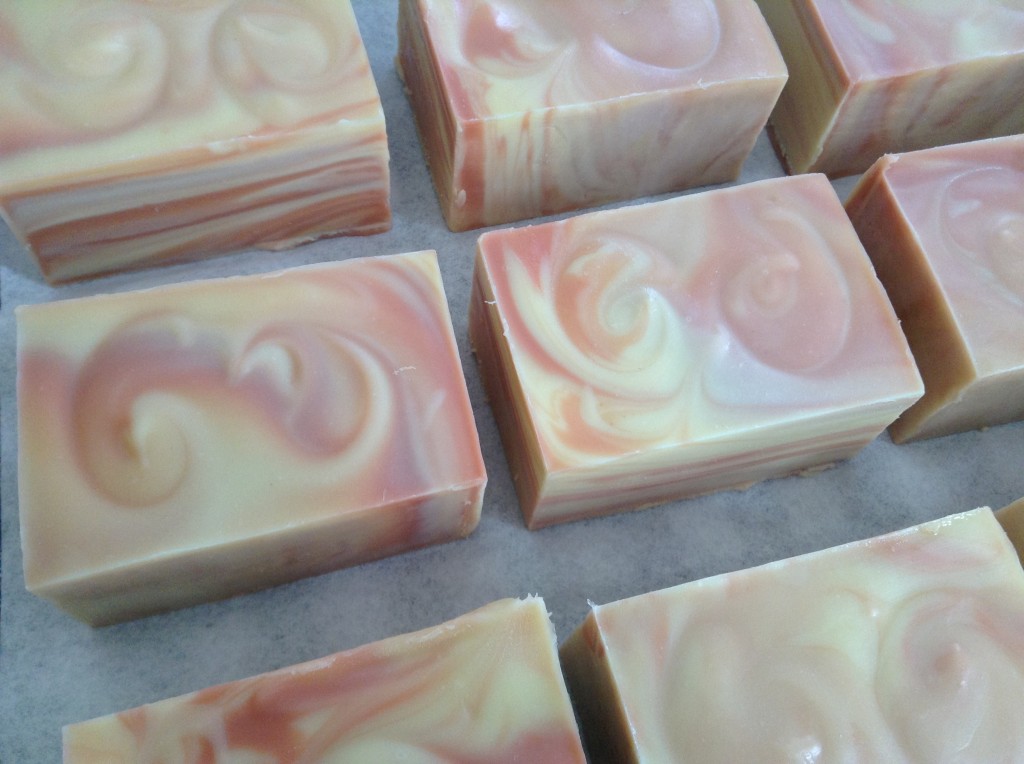I recently made a new facial soap designed to be kind to dry, mature, and/or sensitive skin. Volunteers tried the soap, and based on their feedback, I plan to add it to my regular line.
 I have decided to call this soap Lavender Chamomile Facial Soap. You will likely not smell the chamomile flowers in the final soap, but you will feel the benefits. I infuse the olive oil in the soap with chamomile, which imparts soothing properties to the olive oil. The soap also has lavender essential oil, a 100% natural fragrance that is used in aromatherapy for its calming qualities. French pink clay cleanses and clarifies the skin, removes dead skin cells, and creates and overall refreshed appearance. Buttermilk also helps clarify the skin and helps remove dead skin cells. Lavender Chamomile Facial Soap contains rich shea butter, chamomile-infused olive oil, coconut oil, rice bran oil, apricot kernel oil, avocado oil, and castor oil. In addition to all these goodies, this soap is made with coconut milk, which is cleansing, but not drying or irritating. The fatty acids in coconut milk help to eliminate dirt, impurities, dead skin, and other blemish-causing materials, but they also increase hydration and replenish moisture in your skin.
I have decided to call this soap Lavender Chamomile Facial Soap. You will likely not smell the chamomile flowers in the final soap, but you will feel the benefits. I infuse the olive oil in the soap with chamomile, which imparts soothing properties to the olive oil. The soap also has lavender essential oil, a 100% natural fragrance that is used in aromatherapy for its calming qualities. French pink clay cleanses and clarifies the skin, removes dead skin cells, and creates and overall refreshed appearance. Buttermilk also helps clarify the skin and helps remove dead skin cells. Lavender Chamomile Facial Soap contains rich shea butter, chamomile-infused olive oil, coconut oil, rice bran oil, apricot kernel oil, avocado oil, and castor oil. In addition to all these goodies, this soap is made with coconut milk, which is cleansing, but not drying or irritating. The fatty acids in coconut milk help to eliminate dirt, impurities, dead skin, and other blemish-causing materials, but they also increase hydration and replenish moisture in your skin.
In other words, this soap is chock full of goodies for dry, mature, and/or sensitive skin!
Here is what the beta testers had to say about this soap:
- “I’ve used the soap twice a day for over a week. It lathers well for a facial bar. When I rinse my face then dry it my skin is tight for about a minute, then it feels so soft.”
- “As far as I’m concerned you have a winner. I love it and would buy it!!!!”
- “Oh I love this soap! Its very creamy and smells very good! It does not leave my face dry. I do not need moisturizer after. I love it!”
- “I’ve been using your facial soap for around two weeks now and truly love it! After washing my face, my skin barely feels tight at all! It smells great and leaves my skin feeling so soft and smooth.”
- “I enjoyed the way it made my skin feel clean without drying it.”
- “When washing it feels so smooth, then when my face is dry there is some tightness, but I put a small amount of moisturizing cream on, and it is perfect.”
Two testers have also reported that some mild skin irritations have cleared up since trying the soap. I cannot guarantee you will have the same results. Any soap will probably make your skin feel tight initially, but the testers seemed to say over and over that this feeling is much more temporary with Lavender Chamomile Facial Soap and that they are loving the way their skin feels.
If you do use this soap, I recommend that you still use a bit of moisturizer if your skin is very dry. Try using the soap without moisturizer for a few days to see whether or not the soap alone is conditioning enough for your skin.
UPDATE: You can pre-order this soap from the Etsy store.
[etsy-include=nesoaps;13770776]
Here are the making and unmolding videos of the making of this soap. I will be making a new batch this weekend, so you can look for this new facial soap in my store soon. Let me know if you would like to reserve a bar.


